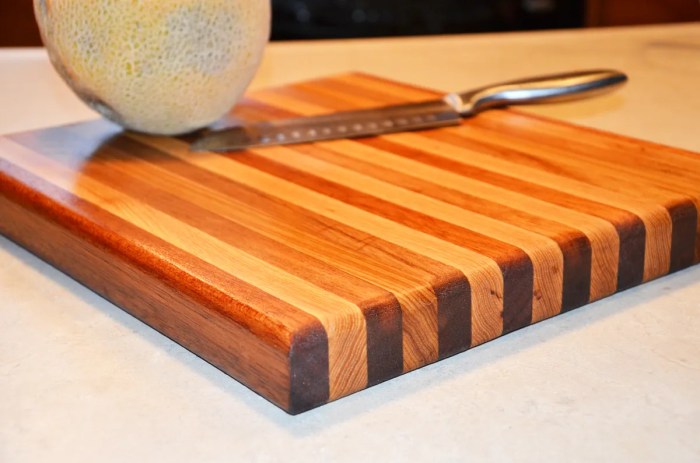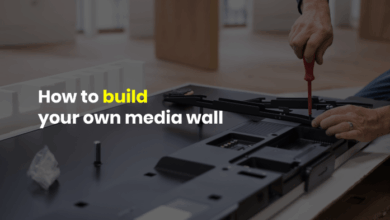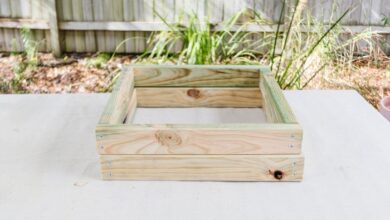
Make your own simple cutting board: It’s a project that combines practicality with a touch of personalized craftsmanship. Whether you’re a seasoned woodworker or a kitchen enthusiast just starting out, building your own cutting board is a rewarding experience.
Not only will you have a beautiful and functional piece for your kitchen, but you’ll also gain a deeper appreciation for the materials and techniques involved.
Imagine the satisfaction of creating a sturdy and stylish cutting board from scratch, using your own hands and carefully chosen materials. It’s a project that allows you to express your creativity and personalize your kitchen space. Plus, making your own cutting board offers the advantage of using eco-friendly materials and ensuring that it meets your specific needs.
Why Make Your Own Cutting Board?
Creating your own cutting board can be a rewarding and practical endeavor, allowing you to personalize your kitchen while ensuring you have a durable and hygienic surface for food preparation. You can choose the wood type, size, and design, making it a unique and functional addition to your kitchen.
Reasons to Make Your Own Cutting Board
Making your own cutting board can be a fulfilling project, especially for those who appreciate woodworking and DIY projects. Here are some key reasons why someone might choose to create their own:
- Customization:You can tailor the size, shape, and wood type to your specific needs and preferences.
- Cost-effectiveness:Building your own cutting board can be more economical than buying a pre-made one, especially if you already have some woodworking tools.
- Unique Design:You can add your own personal touch by incorporating unique designs, inlays, or edge treatments.
- Pride of Ownership:There is a sense of satisfaction in crafting something functional and beautiful for your own kitchen.
Importance of Using a Cutting Board
Cutting boards are essential for maintaining kitchen hygiene and protecting your countertops.
- Food Safety:Cutting boards provide a dedicated surface for food preparation, preventing cross-contamination between raw meat and other foods. Properly cleaning and sanitizing a cutting board after each use is crucial.
- Countertop Protection:Cutting boards shield your countertops from knife marks, scratches, and stains, preserving their appearance.
- Durability:Cutting boards are designed to withstand the wear and tear of regular use, providing a long-lasting and reliable surface for food preparation.
Preparation and Cutting
Preparing the wood for your cutting board is a crucial step to ensure its durability and longevity. This involves selecting the right type of wood, cleaning it, and preparing it for cutting.
Preparing the Wood
The first step is to select the wood for your cutting board. Hardwoods like maple, cherry, walnut, and oak are preferred due to their durability and resistance to scratches and cuts. Softwoods like pine are not ideal for cutting boards as they are prone to dents and scratches.
Once you have selected your wood, it’s important to clean it thoroughly. This can be done with a damp cloth and mild soap. Ensure the wood is completely dry before proceeding. You can also consider using a wood conditioner to help protect the wood from moisture and stains.
Making your own simple cutting board is a fun and rewarding DIY project. It’s a great way to personalize your kitchen and add a touch of rustic charm. If you’re looking for inspiration, check out Rachel Denbow’s blog, at home with rachel denbow , for creative ideas and easy-to-follow tutorials.
With a few basic tools and materials, you can create a cutting board that’s both beautiful and functional, perfect for your next culinary adventure.
Cutting the Wood to Size
After preparing the wood, you can begin cutting it to the desired size and shape. This can be done using a variety of tools, including a table saw, jigsaw, or hand saw.
- Table Saw: This is a good option for cutting large pieces of wood to size. It is important to use safety gear and ensure the blade is sharp and properly aligned.
- Jigsaw: A jigsaw is a versatile tool that can be used to cut intricate shapes. It is important to use a fine-tooth blade and to cut slowly and carefully.
- Hand Saw: A hand saw is a good option for smaller cuts. It is important to use a sharp blade and to cut slowly and carefully.
Creating Rounded Corners, Make your own simple cutting board
Rounded corners not only enhance the aesthetic appeal of your cutting board but also provide a safer experience.
- Router: This tool is ideal for creating smooth and precise rounded corners. Use a round-over bit and carefully guide the router along the edges of the wood.
- Sandpaper: You can create rounded corners by sanding the edges of the wood with progressively finer grit sandpaper. This method is less precise than using a router but is a good option if you don’t have a router.
Assembly and Finishing: Make Your Own Simple Cutting Board
The moment of truth has arrived! After all the meticulous preparation, it’s time to assemble your cutting board and give it that final touch. We’ll explore the process of bringing your individual pieces together, smoothing out any imperfections, and protecting your creation with a durable, food-safe finish.
Gluing and Clamping
Gluing and clamping are essential steps in assembling the cutting board. Wood glue is a popular choice, as it forms a strong bond and is easy to clean up. The key is to apply a thin, even layer of glue to the surfaces that will be joined.
Making your own simple cutting board is a great way to add a personal touch to your kitchen. It’s also a fun and easy project that can be customized to your liking. And while you’re getting crafty, why not try your hand at some easy DIY Christmas tree toppers ?
They’re a fantastic way to add a festive touch to your holiday decor, and they’re sure to impress your guests. Once you’ve mastered those tree toppers, you’ll be ready to tackle any woodworking project, including those cutting boards!
Avoid using too much glue, as it can ooze out and create a messy finish.Once the glue is applied, clamp the pieces together firmly. Use clamps that are evenly distributed along the length of the board to ensure even pressure.
The clamping time will vary depending on the type of glue used, so it’s important to consult the manufacturer’s instructions. Here are some tips for gluing and clamping:
- Use a piece of scrap wood between the clamps and the cutting board to prevent marring the surface.
- Wipe away any excess glue with a damp cloth before it dries.
- Leave the clamps in place for the recommended time to ensure a strong bond.
Sanding Techniques
Sanding is crucial for achieving a smooth and polished surface on your cutting board. It’s a process of gradually removing imperfections and creating a consistent texture.
Making a simple cutting board is a great weekend project, especially if you’re looking for a way to personalize your kitchen. It’s also a fun way to experiment with different wood types and finishes. While you’re working on your cutting board, you might also want to check out this cool stitched photo art project I found online.
It’s a creative way to turn old photos into unique wall art. Once your cutting board is finished, you’ll have a beautiful and practical addition to your kitchen, and you can proudly display your stitched photo art project on the wall.
- Start with coarse-grit sandpaper (80-120 grit) to remove any major imperfections.
- Gradually progress to finer grits (150-220 grit) to smooth out the surface.
- Finish with very fine sandpaper (400 grit or higher) to achieve a smooth, polished finish.
Use a sanding block or orbital sander for consistent results. Sand in the direction of the wood grain to avoid creating scratches.
Food-Safe Finishes
A food-safe finish is essential to protect your cutting board from moisture, stains, and bacteria. It enhances the durability of the board and makes it easier to clean. There are many food-safe finishes available, including mineral oil, beeswax, and polyurethane.
- Mineral oil is a natural and readily available option that penetrates the wood, enhancing its water resistance. It’s best applied in thin coats, allowing each coat to dry completely before applying the next.
- Beeswax provides a protective layer that enhances the appearance of the wood and gives it a natural shine.
It’s often combined with mineral oil for a more durable finish.
- Polyurethane is a durable and water-resistant finish that creates a hard, protective layer. It’s available in both oil-based and water-based formulations.
When applying a finish, it’s important to follow the manufacturer’s instructions carefully. Apply the finish in thin coats, allowing each coat to dry completely before applying the next. Avoid applying too much finish, as it can trap moisture and lead to problems down the road.
Variations and Designs

The beauty of crafting your own cutting board lies in the endless possibilities for customization. You can experiment with different shapes, sizes, and wood species to create a unique piece that reflects your personal style and culinary needs.
This section will delve into the various design options available for simple cutting boards, including different shapes and sizes. We will also explore the use of different wood species and their characteristics for creating unique cutting boards.
Design Ideas
A cutting board’s design is more than just aesthetics; it influences its functionality and overall appeal. Consider these design ideas to inspire your next cutting board creation:
| Shape | Size | Features | Use Case |
|---|---|---|---|
| Rectangular | Large (18″ x 12″) | Juice groove, handle | General-purpose cutting, serving |
| Square | Medium (12″ x 12″) | Rounded corners, beveled edges | Smaller tasks, chopping vegetables |
| Round | Small (10″ diameter) | Handles, raised rim | Cheese boards, serving charcuterie |
| Oval | Large (16″ x 10″) | Rounded edges, integrated handle | Serving bread, pastries |
Wood Species
The choice of wood species significantly impacts the cutting board’s durability, aesthetics, and even its scent. Each wood species has unique characteristics that make it suitable for specific applications.
- Hardwoods:Known for their strength and durability, hardwoods like maple, cherry, walnut, and oak are excellent choices for cutting boards.
- Maple:Renowned for its hardness and resistance to scratches, maple is a popular choice for cutting boards. It features a light, creamy color with subtle grain patterns.
- Cherry:Cherry wood boasts a rich, reddish-brown hue that darkens with age. It’s known for its moderate hardness and attractive grain patterns.
- Walnut:Walnut wood is prized for its deep brown color, distinctive grain patterns, and excellent durability. It’s a good choice for cutting boards that require a more rustic look.
- Oak:Oak is a strong, durable hardwood with a distinctive grain pattern. It’s available in various colors, from light to dark, and is a good choice for cutting boards that need to withstand heavy use.
- Softwoods:While less durable than hardwoods, softwoods like pine and cedar are suitable for cutting boards that are not intended for heavy-duty use.
- Pine:Pine is a softwood known for its light color and distinctive grain patterns. It’s often used for cutting boards that are intended for decorative purposes.
- Cedar:Cedar wood has a distinctive aroma and is known for its natural insect-repelling properties. It’s often used for cutting boards that are intended for serving cheese or other delicate foods.
Safety and Maintenance
A handmade cutting board is an investment in your kitchen, and with proper care, it can last for years. Ensuring its safety and longevity involves understanding the importance of a food-safe finish, practicing proper cleaning techniques, and adhering to safety guidelines.
Food-Safe Finishes
Applying a food-safe finish to your cutting board is crucial. It prevents the wood from absorbing moisture, bacteria, and food particles, ensuring the safety of your food. Food-safe finishes are non-toxic and do not leach harmful chemicals into your food.
Common options include mineral oil, beeswax, and food-grade polyurethane.
Cleaning and Maintenance
Proper cleaning is essential for maintaining the hygiene and longevity of your cutting board.
- After each use, wash the cutting board with warm, soapy water and a soft sponge. Avoid harsh detergents or abrasive cleaners, as they can damage the wood and the finish.
- Rinse thoroughly and dry completely with a clean cloth. Moisture left on the surface can encourage bacteria growth.
- Periodically, apply a food-safe finish to the cutting board to replenish its protective layer. This helps prevent cracking and warping and keeps the wood looking its best.
- To disinfect your cutting board, you can use a solution of one part white vinegar to two parts water. Wipe the surface with the solution, let it sit for a few minutes, and then rinse and dry thoroughly.
Safety Precautions
Using and storing your cutting board safely is vital to prevent accidents and ensure its longevity.
- Avoid cutting directly on the surface of the cutting board, as this can lead to scratches and damage. Use a cutting mat or a separate cutting board for tasks like cutting raw meat.
- Always wash the cutting board thoroughly after cutting raw meat or poultry. Bacteria can linger on the surface and contaminate other foods.
- Avoid placing hot pots or pans directly on the cutting board, as the heat can warp or damage the wood.
- Store your cutting board in a dry, well-ventilated area. Avoid storing it in direct sunlight or in a humid environment.






